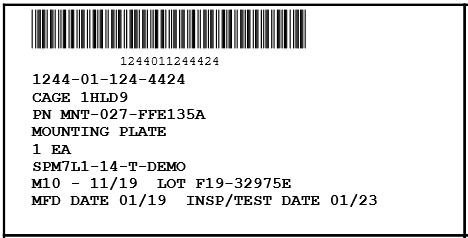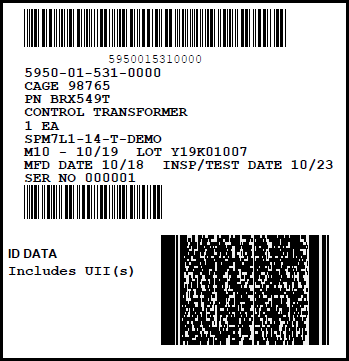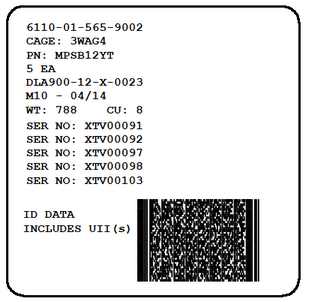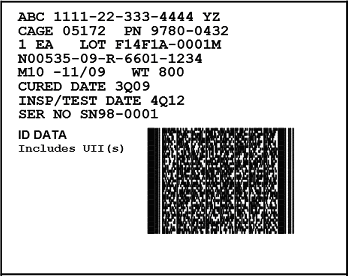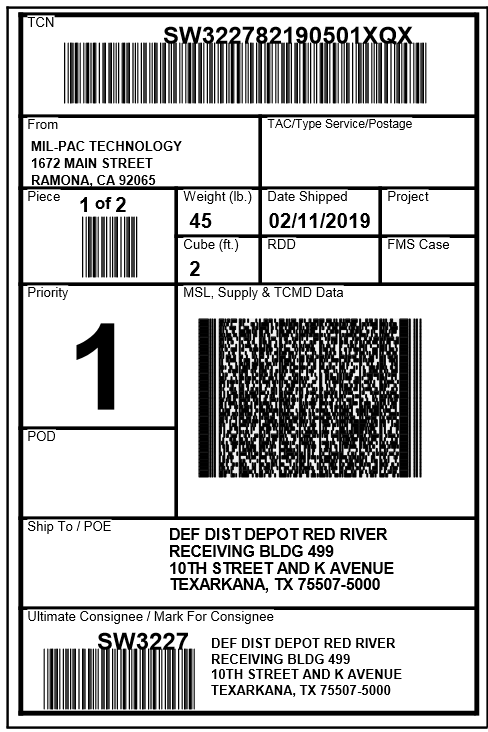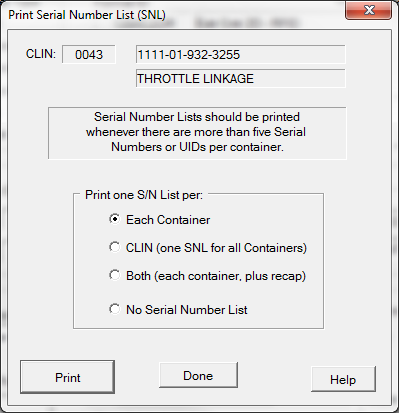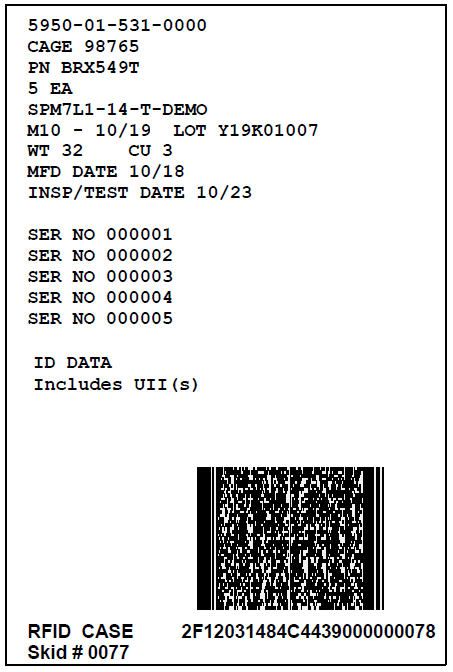Mil-Std-129R compliance includes a wide range of requirements. MIL-Comply/Labeling supports:
 Unit Container Labels
Unit Container Labels
|
MIL-Comply Labeling includes a variety of compliant unit container labels to fit a variety of labeling requirements. The basic 2x4-inch label is the most popular. A variant that replaces the linear barcode with a two-dimensional PDF417 symbol is available, however, the linear barcode is most easily read in the field as it does not require sophisticated imaging scanners or software to interpret the PDF417 data structure. Unit containers that include UID-marked items require the two-dimensional PDF417 symbol. This version of the label retains linear barcodes for the NSN and serial number, again, because they are most easily readable in the field, using low-tech scanners. However, the PDF417 symbol includes all of the data required by Mil-Std-129R, including the UII and serial number. For smaller containers, a variant with just the PDF417 symbol is available, which is fully compliant with Mil-Std-129R.
|
 Exterior Container Labels
Exterior Container Labels
|
Revision R of MS-129 codified the use of the two-dimensional PDF417 symbol as a substitute for the myriad of linear barcodes required in previous revisions. The example a right would require eight linear barcodes in previous revisions (including the shipment and CLIN), and two six-inch labels. The 2D PDF417 also offers a big advantage to depots and other defense activities. The symbol contains all of the data printed in the clear and can be fully interpreted by computers receiving it because all of the data elements include an accompanying Data Identifier. The reading of linear barcodes has to be orchestrated in a way that allows each read to be matched up with a data field. The exterior container format with the maximum of five UIDs/SNs listed, shown at right, requires a 4x5-inch label. A more compact version is available for smaller exterior containers that include only a single UID. |
 Military Shipment Labels (MSL)
Military Shipment Labels (MSL)
|
MIL-Comply includes the standard Military Shipment Label and an RFID-enabled MSL, both of which print on 4x6-inch labels. The standard version may be printed on laser sheets and cut out. The MSL generated by MIL-Comply differs somewhat from the "Generic MSL" depicted in Figure 2A and B of Mil-Std-129, which are offered by the standard as "examples of acceptable MSL formats that may be used as guidelines in producing a label." MIL-Comply, for example, diminishes the large POE and POD fields which are rarely (if ever) used by defense contractors. Use of DD1387The use of DD Form 1387, superseded by the MSL, is used under these circumstances: “Attach a DD Form 1387 (Military Shipment Label) in lieu of a bar coded MSL for DoD contingency operations where manual entry is the only means available to document DTS shipments.” [Mil-Std-129R §5.2.1]
|
 UID Container Labels
UID Container Labels
Starting with Revision R, Mil-Std-129 required that the UII and serial number of UID-marked items be included in a two-dimensional PDF417 symbol. The serial number is also included in-the-clear. Examples of this are included in the Unit Container and Exterior Container sections, above. |
 Barcoded Serial Number Lists
Barcoded Serial Number Lists
|
Barcoded Serial Number Lists MIL-Comply prompts the user whenever this situation occurs. There are three kinds of serial number lists available to meet specific contract requirements. •One Serial Number List (SNL) per container •One SNL per CLIN - combining all containers •Both of the above The first choice meets Mil-Std-129 and most contract requirements. A combined list of all serial numbers or UIDs shipped, per line item, is useful for some contracts and for internal documentation. |
 RFID-enabled Labels
RFID-enabled Labels
|
Support for RFID is robust and tightly integrated within MIL-Comply, from Labeling to Shipper. There are RFID-enabled variants exterior container formats, as well as some unit containers and the Military Shipment Label (see above).RFID-tagged exterior container labels can be automatically palletized, with the CLIN and UID data being automatically aggregated for submission to WAWF. Complex shipments with UIDs and RFID-tagging may be imported, automatically generating the container labels and collecting the data for WAWF submission. This makes simple even the most complicated shipments, such as unit-level RFID tagging of UID unit containers, into arbitrarily tagged RF-Cases and Pallets, with automatic aggregation of the data for WAWF submission. Submitting RFID to WAWFRFID data may be submitted to WAWF as part of an EDI Receiving Report (DD250) prepared by Shipper or Contract Manager. It may also be provided separately as an RFID Pack Update by RFID Manager. More about WAWF EDI Transactions. |
See also:
PDF417 Data Dump - 2D Symbol Data Structure
